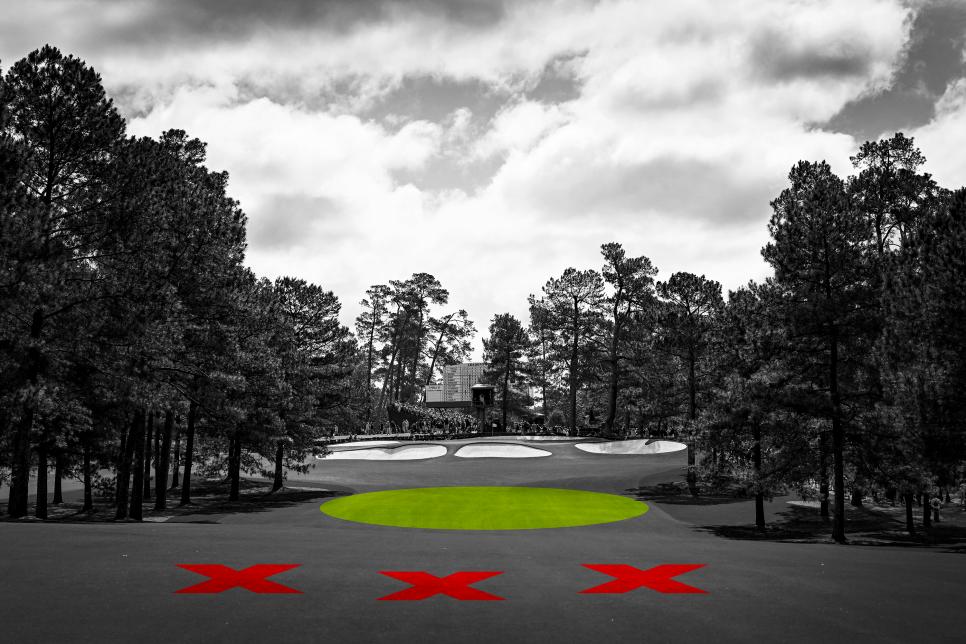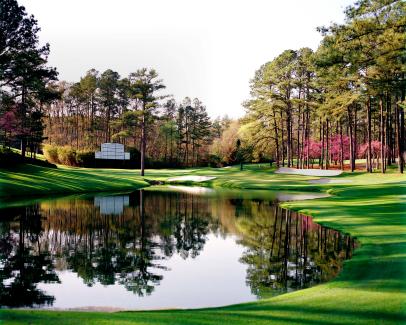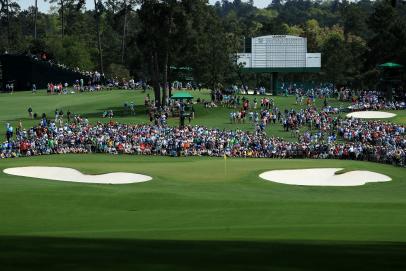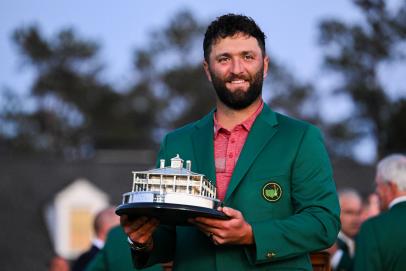Strategy
Masters 2024: 5 shots that players should never hit at Augusta National

Take a moment and visualize Augusta National Golf Club. How many holes come clearly into view? A lot, right? Aside from your home track and a handful of other famed layouts, there might be no course that you are more familiar with than Augusta—and chances are you’ve never even played it!
That familiarity comes from watching decades of Masters moments, which have in turn taught us the fundamentals of Alister MacKenzie’s creation and the strategy needed to play it well. You draw it around the corner on 10 and 13. You use the slope in the middle of the green at the par-3 16th. And do your best to keep it between the Georgia Pines on 18.
The problem, however, is that the way history suggest Masters competitors “need” to play various holes at Augusta is becoming outdated, a result of both equipment advances and a better understanding of statistics. An expert on the latter, DECADE Golf founder Scott Fawcett believes a new approach needs to be taken on some holes, while on others, the old strategy still holds.
Each year at the Masters (as well as the other three men’s major championships), Fawcett gives his tour players a packet with the ideal line off every tee and the best strategy for playing each hole as proven by stats. We caught up with Fawcett to better understand the common strategy mistakes that some players continue to make.
These are Fawcett’s five shots that players should never hit at Augusta National.
1. Iron off the tee on No. 3

During last year’s Masters, Fawcett got into a heated debate on social media with CBS analyst and former tour player Colt Knost about whether players should lay up on the short par-4 third. At only 350 yards, it would seem on paper to be one of the easier holes on the course, yet it regularly plays over par, with a historical average of about 4.1. Much of that is due to the green being very shallow, requiring precise distance control on approach shots.
The traditional logic at the third is that players should lay up around the fairway bunkers, especially when the hole location is on the left side of the green, so that they have a full wedge shot for their second. The theory is that they can better control their spin. Fawcett doesn’t buy it no matter where they place the pin.
“What you want to do is send it up there around the green, and you figure it out from there,” he says. "The main reason is it’s just too narrow [on the lay-up].” Often, when players choose to lay up, they assume they will hit the fairway, Fawcett says. Up by the fairway bunkers, though, the fairway is only 25 yards wide. Even though an iron should give you more control off the tee, avoiding the bunkers and trees is not guaranteed.
“You don’t get to place it in the fairway, and your remaining shot is still extremely hard,” he says, adding that the green is a tiny target to hit, even with a 125-yard wedge shot. “You’ve got this depth situation, and you just don’t have that much distance control to be able to hit it that perfectly.”
The solution, he argues, is to hit driver over the bunkers, where the landing area is 65 yards wide at 300 yards off the tee. Based on tour players’ shot patterns (in other words, how far left and right their misses go), players will hit that landing area 95 percent of the time. From there, he says, it’s OK to take a conservative line into the green, even with the short pitch shot. Avoiding a bogey (or worse) here early in the round should be the ultimate goal.
“Making a par all four days on this hole gains you a third of a shot [on the field],” Fawcett says. “That’s a huge gain.”
2. Faders trying to draw a driver

Augusta National famously caters to players who can work the ball from right-to-left, as several holes bend in that direction, notably the second, 10th and 13th. The issue is that most modern tour pros prefer to hit a fade with the driver.
Faders are then left with a few options on these pivotal holes: 1) try and stick with their fade off the tee, 2) drop back to an easier-to-draw 3-wood or 3) hit driver and try to force a draw. Yet often, that last option—trying to manufacture a draw with a driver—is where players invite big misses into play.
“The thing that people get wrong is they try to work their drivers too much,” Fawcett says. “I think that’s a big problem for Rory [McIlroy] is he tries to work the driver too much. You get up on a hole like No. 2 and you basically have to turn it over. A lot of guys should be hitting 3-wood for sure.” Same for the 10th hole, where Fawcett thinks too many players try to draw a driver because of the hole's length.
The issue for a fader trying to draw a driver is that modern drivers and golf balls have less spin. When a fader draws a driver, often it won’t have enough spin, so it either won’t draw or it will over-draw and dive out of the air.
“The driver is the only club in the bag that you fit for one particular shape,” Fawcett says. “If your stock shot is a fade, when you try to draw it, it’s going to be a knuckle ball."
The better option, Fawcett says, is for faders to drop back to 3-wood on the holes that bend excessively from right-to-left. Since 3-woods have more loft and more spin, they are easier to curve, and thus players will be able to work the ball around the corners consistently.
3. Fairway wood into Nos. 13 or 15

Until the last few years—when substantial yardage has been added to both par 5s on the second nine—it would be ridiculous to presume any player would have a fairway wood into the 13th or 15th holes, as nearly everyone was able to get home in two with an iron. Not anymore.
A lengthening of the 13th hole prior to the 2023 Masters has it now playing 545 yards, with many players no longer able to cut the corner of the dogleg. The 15th now plays 550 yards after a similar lengthening. The result is that shorter players, or those who mishit their tee shots, will likely have between 230 and 250 yards for their second shots into the green.
That is about the distance where players should start to consider laying up, Fawcett says. “Once you’ve got anything that has a headcover on it, just too much can go wrong and not enough good can happen,” he says. “A good checklist for players is, Will I ever get this putting? And if so, it implies that a lot of the rest of your shot pattern is in pretty good shape.”
Especially on the 15th hole, where the green is quite shallow, it is difficult to get a fairway wood to reliably stop on the green. And with water short and long, the penalty for poor distance control is steep. On both holes, Fawcett says, if you choose to go for the green with a fairway wood, you might make more birdies, but those birdies will be offset with more penalty shots and bogeys.
Fawcett does concede that there is more nuance to the decision on whether to go for it on these holes. Most of the time, however, if players have a mid- or long-iron, he says they should go for it, and if they have a hybrid of fairway wood, they should lay up.
4. Aiming at the right side of the green on No. 12

On paper, the 155-yard par-3 12th should be a bit of a pushover—a flick of a 9-iron or wedge—but MacKenzie’s brilliant design makes Golden Bell historically the fourth toughest on the course. This is in large part because the shape of the green, which is angled from short-left to long-right.
The genius of this subtle design is that shot patterns for right-handed golfers are also “angled,” but in the opposite direction, from long-left to short-right. This is because pulls tend to fly farther, and pushes fly shorter. Apply those misses to the 12th, and a long-left shot is in the back bunkers or trees, while a flared right shot is in Rae’s Creek.
That is the reason players should almost never be aiming at any hole location on 12, especially on the right side of the green, Fawcett says. “Dead center of the green, almost regardless of hole location” he says is where players should aim.
OK, easy enough—but players often get in trouble by aiming at the middle of the green and hoping they miss it a little left or right to get closer to the hole. Remember, if a right-hander pulls an iron shot, it will fly long, and if you push it, it will come up short. Those misses are harshly penalized on the 12th.
“You can’t aim five yards left of a flag and then ‘hope’ you push it,” Fawcett says. “Every single tour player that I’ve ever worked with, they just laugh at that. They’re like, ‘Dude, I do that all the time.’ ”
This is what Jordan Spieth did wrong in 2016, Fawcett says. Spieth came to the 12th with the lead on Sunday before finding the water twice and eventually losing to Danny Willett. He correctly aimed at the middle of the green, but then tried to push it over to the right hole location.
“Now you’re aiming away from a flag and putting a wishy-washy swing on it,” Fawcett says. “That’s what Jordan did. That’s obviously a recipe for disaster.”
5. Laying back off the tee on No. 7

Perhaps no hole at Augusta better highlights Fawcett’s strategy of taking driver (unless penalty areas are closely in play) and sending it as far as you can than the long, narrow par-4 seventh. The hole plays 450 yards, but there is only about 40 yards between the trees at 300 yards, so many players decide to drop back to fairway wood or iron to get the ball in play.
That’s incorrect strategy, Fawcett says. “Definitely too many people drop back on seven. The hole is 450, and it’s not like you get to place the ball in the fairway,” he says.
“If dropping back [to less than driver] doesn’t remove the trouble, then you just go ahead and send it, but if dropping back to 3-wood does improve the width, then that would be a spot to drop back,” Fawcett says of the typical calculus off the tee. “Dropping back to 3-wood on this hole is not going to make it any wider but dropping back to 2-iron certainly will.”
The issue is, the hole is fairly long and the green is so small, so when players drop back to a long iron, they are leaving themselves a lengthy approach, while not also guaranteeing that they will even find the fairway. As Fawcett says, “Tacking on 70 yards to 100 percent of you second shots in a bad idea.”
Instead, Fawcett prefers players hit driver. At 300 yards off the tee, there is about 40 yards between the trees, and based on tour data, players should be able to keep it between the trees at least 60 percent of the time. That may sound like a low number, but Fawcett argues the trees aren’t a terrible position, especially on a hole that averages well over par.
“That’s where we’re just looking for a little bit of luck,” he says of having a clear shot when in the trees. “At the end of the day, winning requires luck, so we’re trying to set up the cards to where we might be able to get a little bit of luck to win these golf tournaments.”










